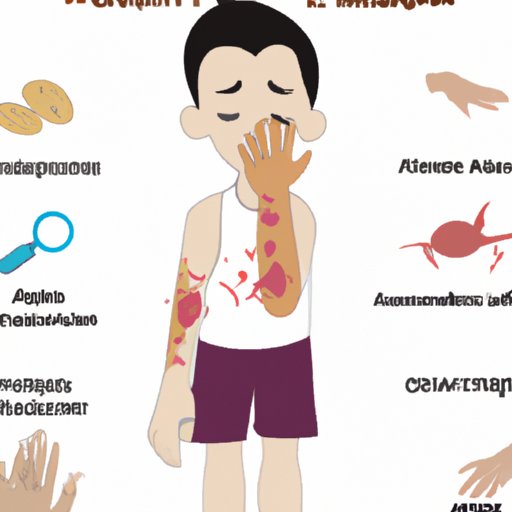Introduction
A skin rash is an area of irritated or inflamed skin that may range from mild to severe. It can cause an itchy sensation, as well as redness, swelling, and even blistering. Skin rashes can be caused by a variety of factors, including allergies, autoimmune disorders, infections, and stress.

Common Types of Skin Rashes and Their Causes
Atopic dermatitis, also known as eczema, is one of the most common types of skin rashes. It is characterized by patches of dry, itchy, and inflamed skin. It can be caused by environmental factors such as allergens, irritants, or changes in temperature. It can also be triggered by stress or hormonal changes.
Contact dermatitis occurs when the skin comes into contact with an allergen or irritant. The most common cause is poison ivy, but other irritants such as detergents, perfumes, and jewelry can also cause a reaction. Symptoms include itching, redness, swelling, and blistering.
Seborrheic dermatitis is a chronic condition characterized by red, scaly patches on the scalp, face, chest, and back. It is thought to be caused by an overgrowth of a type of yeast found on the skin. It is more common in people who have oily skin, a weakened immune system, or certain medical conditions.
Psoriasis is another common type of skin rash. It is an autoimmune disorder that causes raised, red, scaly patches on the skin. It is thought to be caused by genetic and environmental factors, such as stress, smoking, and certain medications.
Allergies and Skin Rashes: What You Need to Know
Allergic reactions can cause a wide range of symptoms, including skin rashes. Symptoms of an allergic reaction may include itching, hives, swelling, and redness. In some cases, anaphylaxis, a life-threatening reaction, can occur.
When exposed to an allergen, the body’s immune system releases chemicals such as histamine. These chemicals cause the body’s blood vessels to widen, which can lead to skin rashes. Allergic reactions can be treated with antihistamines, steroids, or epinephrine.

Understanding Autoimmune Skin Disorders and Their Causes
Autoimmune disorders are caused by the body’s immune system attacking its own cells and tissues. Examples of autoimmune skin disorders include lupus, scleroderma, and vitiligo. Symptoms may include redness, itching, and swelling, as well as discoloration and thinning of the skin.
The exact cause of autoimmune disorders is unknown, but it is thought to be due to a combination of genetic and environmental factors. Treatment typically involves managing symptoms with medications, such as corticosteroids and immunosuppressants.
Skin Infections: Identifying the Causes
Bacterial, fungal, and viral infections can all cause skin rashes. Bacterial infections, such as impetigo and cellulitis, are caused by bacteria entering the skin through cuts or other breaks in the skin. Symptoms may include redness, swelling, and pus.
Fungal infections, such as athlete’s foot and ringworm, are caused by fungi that enter the skin through contact with an infected person or object. Symptoms may include itching, scaling, and blisters. Viral infections, such as chickenpox and shingles, are caused by viruses that enter the body through contact with an infected person or object. Symptoms may include fever, blisters, and itching.
The Role of Stress in Skin Rashes
Stress can affect the body’s immune system and lead to skin rashes. When we are stressed, our bodies produce hormones that can weaken the immune system, making us more susceptible to skin rashes. Stress can also worsen existing skin conditions, such as eczema and psoriasis.
Treating stress-related skin rashes typically involves reducing stress levels through lifestyle changes, such as exercise and relaxation techniques. Medications, such as antihistamines and corticosteroids, may also be used to reduce inflammation and itching.

Natural Remedies for Treating Skin Rashes
There are several natural remedies that can help treat skin rashes. Herbal remedies, such as chamomile and calendula, can help reduce inflammation and itching. Home remedies, such as oatmeal baths and cold compresses, can also provide relief. Dietary changes, such as avoiding foods that trigger allergies, can help reduce symptoms.
Conclusion
Skin rashes can be caused by a variety of factors, including allergies, autoimmune disorders, infections, and stress. It is important to identify the underlying cause of a skin rash so that it can be properly treated. Natural remedies, such as herbal remedies, home remedies, and dietary changes, can also be used to treat skin rashes.
To prevent skin rashes, it is important to avoid triggers such as allergens, irritants, and stress. Wearing protective clothing and avoiding direct contact with infected people or objects can also help prevent skin rashes.


